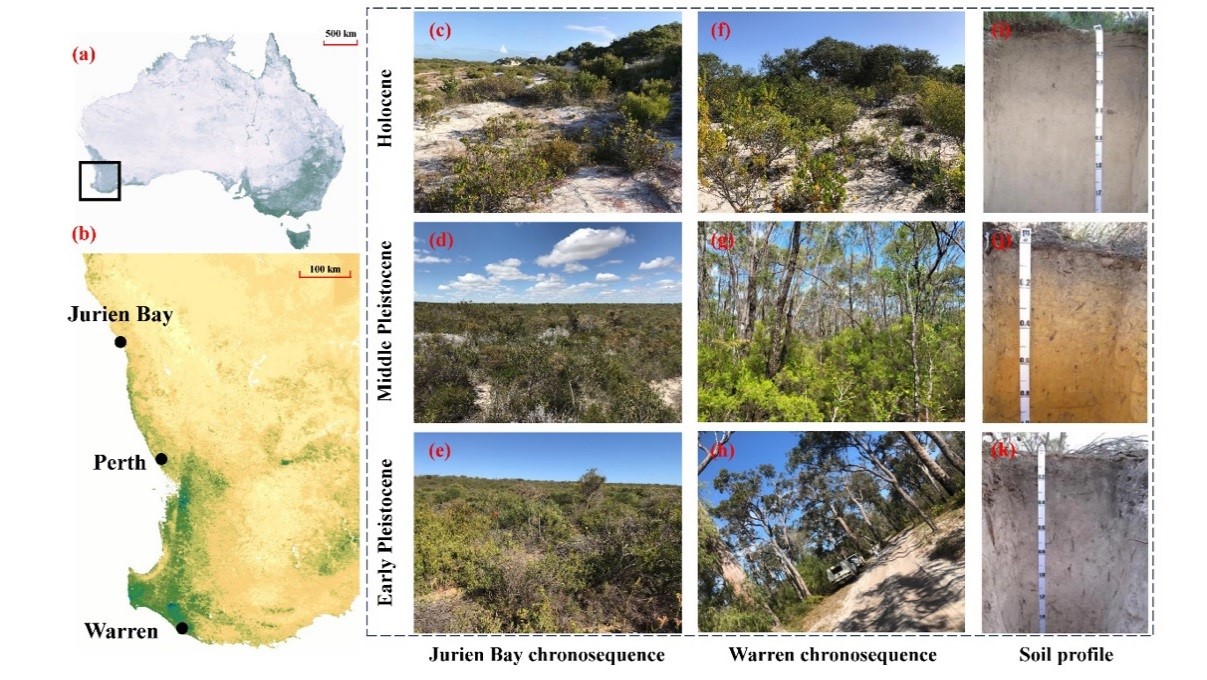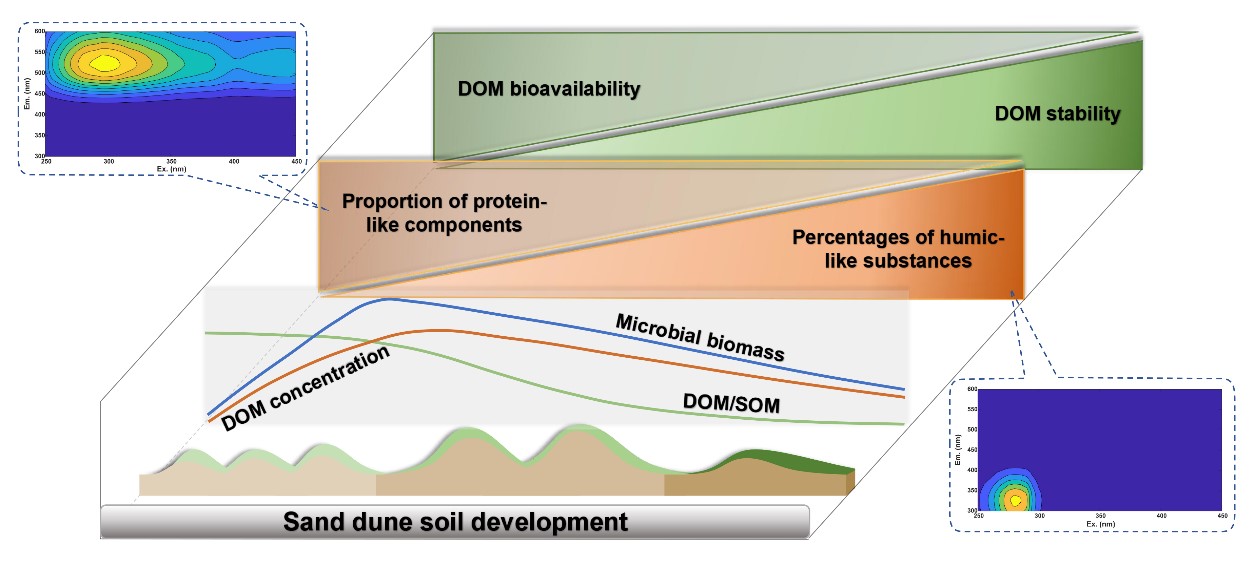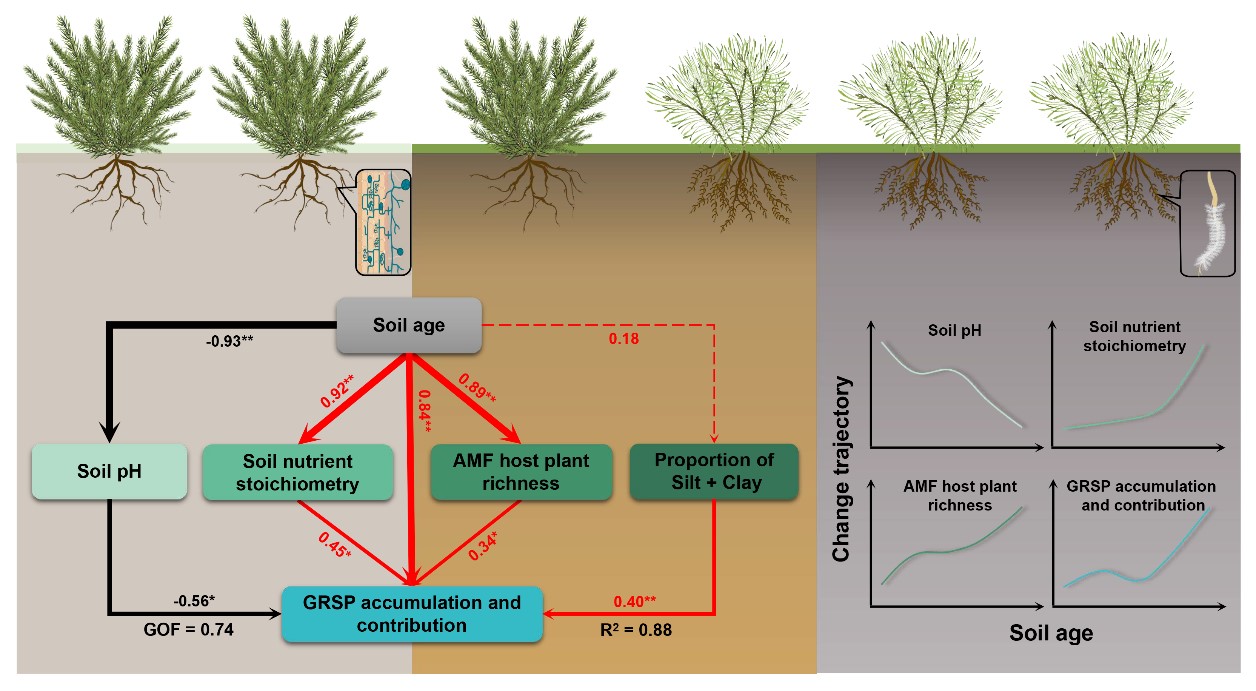200,000-Year Dune Chronosequence Reveals Synergistic Regulation of Climate and Pedogenesis on Soil Organic Matter Transformation
Against the backdrop of intensifying global climate change, a deeper understanding of soil carbon sequestration mechanisms is crucial for enhancing the carbon sink function and stability of terrestrial ecosystems. Dissolved organic matter (DOM) and glomalin-related soil protein (GRSP), as key components of the soil carbon pool, play pivotal roles in the accumulation and stabilization of organic carbon. However, their distribution patterns, dynamic characteristics, and regulatory mechanisms during long-term ecosystem development remain unclear. The restoration ecology team at the South China Botanical Garden, Chinese Academy of Sciences, selected two coastal dune chronosequences spanning 2 million years—Jurien Bay in a hot, arid climate and Warren in a wet, cold climate (Figure 1)—to systematically analyze the influence of climate and pedogenesis on the characteristics of DOM and GRSP and their impact on soil organic carbon dynamics.

Figure 1. Schematic diagram of the study area.(Imaged by MOU et al)
Functional Shift of DOM: From Nutrient Supply to Carbon Sink Stabilization
Using fluorescence excitation-emission matrix (EEM) spectroscopy combined with parallel factor analysis (PARAFAC), the research team found that the accumulation level and humification index of DOM in the wet, cold climate (Warren) were significantly higher than those in the hot, arid region (Jurien Bay), indicating greater stability. This disparity primarily stems from differences in vegetation input, carbon supply, and soil environment. Further analysis revealed that during the early stages of ecosystem development, DOM concentrations were higher and rich in protein-like and microbially derived components, serving as a vital nutrient source for plants and microorganisms. In contrast, during the degradation stage, DOM gradually shifted to more stable components such as humic and fulvic acids, transitioning from promoting nutrient turnover to enhancing carbon pool stability (Figure 2).

Figure 2. Evolution of dissolved organic matter (DOM) across dune ecosystem development.(Imaged by MOU et al)
"Counterintuitive Accumulation" of GRSP: Carbon Accumulation Mechanism Under Long-Term Nutrient Depletion
The study reported for the first time the phenomenon of GRSP (particularly EE-GRSP) significantly accumulating in ancient phosphorus-deficient soils despite a decline in arbuscular mycorrhizal fungi (AMF) biomass. This "counterintuitive accumulation" arises from plants increasing belowground carbon allocation to stimulate AMF biomass turnover, while being co-regulated by soil acidity, nutrient stoichiometry, and the diversity of mycorrhizal plants. The research confirmed that GRSP significantly promotes the accumulation and stabilization of soil organic carbon (SOC), maintaining its critical carbon sink function even under long-term nutrient limitation (Figure 3).

Figure 3. Accumulation characteristics of glomalin-related soil protein (GRSP) and its influencing factors.(Imaged by MOU et al)
This study is the first to reveal the differential mechanisms by which climate and pedogenesis regulate the accumulation of DOM and GRSP and their carbon sink functions, providing new theoretical insights into the spatiotemporal evolution of soil carbon accumulation and stabilization under global change. The findings not only deepen the understanding of soil carbon cycling mechanisms but also offer important scientific foundations for carbon sink management and ecological restoration practices in island and coastal ecosystems. The research results have been published in international soil science journals Catena and Plant and Soil. Postdoctoral researcher MOU Zhijian from the South China Botanical Garden restoration ecology team is the first author, with Researcher LIU Zhanfeng as the corresponding author. Collaborators include Professor Hans Lambers from the University of Western Australia, Professor Ellen Kandeler from the University of Hohenheim, and Professor Benjamin Turner from Gyeongsang National University. The study was supported by the National Key R&D Program of China, the National Natural Science Foundation of China, and the Guangdong Provincial Science and Technology Plan.
Paper Links:
https://doi.org/10.1016/j.catena.2025.109004
https://doi.org/10.1007/s11104-025-07391-w
File Download: